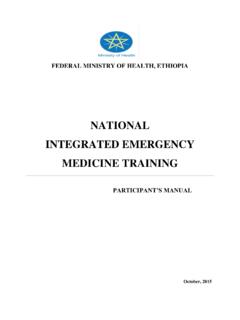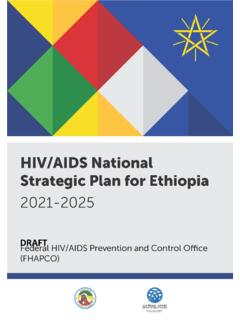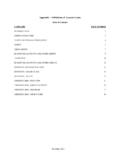Transcription of Health Sector Transformation Plan II HSTP II
1 HSTP II. Health Sector Transformation Plan II. 2020/21-2024/25. (2013 EFY - 2017 EFY). February 2021. CONTENTS.. 3. List of .. 5. Executive 9. Chapter 1: 12. Chapter 2: Country Context .. 14. Chapter 3: Performance of Health Sector Transformation Plan I Situation Analysis .. 17. Health status and economic gains .. 20. The state of healthy life .. 20. Major causes of mortality and 20. Economic 21. The status of Health system performance .. 22. Progress towards universal Health 22. Healthy lifestyle and 22. Demand for Health 22. Health security, Health system resilience, and lessons from the COVID-19 22. Health system 23. Service 23. Service delivery platforms of the Health 24. Reproductive, Maternal, Neonatal, Child, Adolescent and Youth Health (RMNCAYH).
2 24. Prevention and control of major 26. Health 28. The state of equity in the Ethiopian Health system .. 29. Geographic disparities in 29. Gender disparities in 30. Socioeconomic 30. Health system inputs .. 31. Health Workforce .. 31. Medical products and supplies .. 31. Health infrastructure .. 32. Health 32. Health information .. 33. Community engagement .. 34. Leadership, governance and multi-sectoral 34. Leadership and governance .. 34. Multi-sectoral collaboration .. 35. SWOT Analysis .. 35. Stakeholder Analysis .. 37. Summary of Lessons from HSTP-I implementation .. 38. HSTP II | 2020/21-2024/25. 2013 EFY - 2017 EFY 1. Chapter 4: Health Sector Transformation Plan II: Objectives, Targets, and Strategic Directions .. 40. Vision.
3 41. Mission .. 41. Values .. 41. Objectives .. 41. Targets .. 44. Strategic Directions .. 47. Priorities / Transformation Agendas of 66. Chapter 5: Costing and Financing .. 67. Costing .. 68. Financial space and costing analysis .. 77. Financial Gap analysis .. 84. The Financing Gap: Business as Usual .. 85. Financing the Gap .. 86. Other Financing the Gap Options .. 87. Chapter 6: Implementation Arrangement .. 89. Integration of initiatives .. 90. HSTP-II governance .. 91. Planning and budgeting .. 92. Health service delivery arrangements .. 94. Optimizing monitoring and review systems .. 95. Multi-sectoral collaboration .. 95. Public-private partnership .. 96. Fostering innovation through Health technology assessment and adaptation.
4 97. Health diplomacy, Communication and visible leadership .. 97. Risks and Mitigation .. 98. Chapter 7: Monitoring and Evaluation Plan .. 99. Monitoring and Evaluation Framework .. 100. Indicators .. 100. Index measurement in HSTP-II .. 101. Transforming Data into Information and Action: The Data Cycle .. 102. Evaluation .. 103. Dissemination and communication .. 103. Coordination, Policy and Institutional Environment for Monitoring and Evaluation .. 104. Annex 1: Indicators and Targets of HSTP-II .. 106. ANNEX 2: Equity indicators and targets .. 111. Annex 3: References .. 112. 2 HSTP II | 2020/21-2024/25. 2013 EFY - 2017 EFY. FOREWORD. Ethiopia has implemented the first Health Sector Transformation Plan (HSTP-I) from 2015/16 to 2019/20, during which significant achievements were registered in improving the Health of our population and increasing access to and utilization of Health services.
5 Health outcome indicators have shown improvement, with a remarkable reduction in morbidity and mortality from major communicable diseases such as HIV, tuberculosis and malaria. Maternal and child Health has also improved that resulted in saving the lives of millions of women and children. Despite significant improvements, mortality and morbidity from communicable diseases and maternal and child Health conditions are still high. The prevalence of non-communicable diseases (NCDs) and injuries are on the rise creating a triple burden of diseases for the Health system. There is a high disparity in service utilization and Health outcomes among people in different geographical areas and socio-economic groups. The quality of Health care is still sub-optimal.
6 The Health system is also challenged by emerging pandemics such as COVID-19. Lia Tadesse Minister of Health , The second Health Sector Transformation plan (HSTP II). Federal Democratic Republic of Ethiopia is the Sector 's five years strategic plan from 2020/21- 24/25. It aims at improving the Health of our population through the realization of accelerating progress towards Universal Health Coverage (UHC), protecting people from emergencies, creating Woreda Transformation and making the Health system responsive to people's needs and expectations. To measure progress towards these objectives, HSTP-II has set ambitious but realistic targets that are aligned with national 10 years development plan and international targets such as the Sustainable Development Goals (SDGs).
7 The plan has identified 14 key strategic directions that define the major strategic areas and initiatives of the strategic period. The plan aspires to achieve UHC through expanding access to services and improving the provision of quality and equitable comprehensive Health services at all levels. We will expand Health services based on the recently revised Essential Health Services Package (EHSP), through which different high impact interventions will be made available for each respective level of care. Reproductive, Maternal, Newborn, Child, Adolescent and Youth Health will continue to be the major focus areas. We will continue to strengthen the prevention and control of major communicable diseases such as HIV, Tuberculosis and Malaria.
8 As NCDs and mental Health problems are becoming public Health concerns, we will give a special focus on the prevention and control of NCDs and mental Health problems, mainly through integrating these services with the primary Health care system. The Health extension program (HEP) will be revitalized based on the newly revised HEP roadmap where more essential Health services will be expanded to make services more accessible to the population. To protect the population from emergencies, we will focus on strengthening our public Health emergency management system and work towards building a resilient Health system. The plan also focuses on strengthening Health investment areas such as medicines, information Health workforce, Health infrastructure, digital Health and innovations in Health .
9 The plan also emphasizes on strengthening multi-sectoral collaborative approach through which we can tackle the social determinants of Health . Strengthening the engagement of the private Sector in the Health Sector priorities is also identified as a major strategic area. HSTP II | 2020/21-2024/25. 2013 EFY - 2017 EFY 3. From the 14 strategic directions, we have identified five priority areas/ Transformation agendas, which will be the top priority issues of the Sector . These include Quality and Equity of Health Services, Information Revolution, Motivated, Competent and Compassionate Health workforce (MCC), Health Financing and Leadership. The first priority area, , quality and equity aspires to improve the provision of quality and equitable services to the population.
10 A national quality and equity strategy towards achieving narrowing Health disparities is being developed and equity and quality will be mainstreamed in all of our Health programs with regular measurement and improvement. Information revolution will continue to be the priority in HSTP-II as availability and use of quality data are key for informed evidence-based decision-making in the Sector . The Sector will focus on improving the production and use of quality of data, with a special focus on improving the routine Health management information system (HMIS). As a key priority area, the Sector will focus on creating a motivated, competent and compassionate Health workforce, which will be one of the key inputs to provide quality and responsive Health service.







